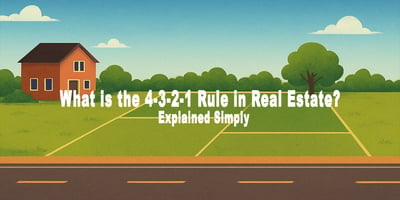If you’ve been around real estate for more than five minutes, you’ve probably heard someone drop...
What Is the 7% Rule in Real Estate? (No Fluff Explanation)

Most people overcomplicate real estate.
They drown in spreadsheets, 20-page pro formas, and analysis paralysis.
Successful investors don’t do that.
They use rules of thumb to cut through the noise.
One of the simplest? The 7% Rule.
The Short Answer
The 7% rule is a quick filter.
It says:
If a property can’t generate at least 7% of its purchase price in annual rent, it’s not worth your time.
That’s it. No fluff.
How to Use It
Math time (don’t worry, it’s simple):
- Take the purchase price.
- Multiply it by 0.07.
- That’s the minimum annual rent you should expect.
Example:
- Property price: $200,000
- 7% of $200,000 = $14,000
- Divide by 12 = $1,166/month
So if that property doesn’t pull in at least $1,166 a month, forget it. Move on.
Why This Matters
Too many investors get emotional.
They fall in love with granite countertops, nice neighborhoods, or what the seller says.
Money doesn’t care about feelings.
The 7% rule keeps you disciplined. It forces you to judge deals by the numbers, not the story.
If the deal can’t even clear this basic bar? It’s not a deal.
7% Rule vs. 1% Rule
You’ve probably heard of the 1% rule too.
That one says:
Monthly rent should be at least 1% of the purchase price.
So a $200,000 property should rent for $2,000/month.
That’s stricter. Harder to find in expensive markets.
The 7% rule is a little more forgiving. It focuses on annual rent instead of monthly rent.
Both are useful.
Smart investors run deals through both filters.
The Catch
The 7% rule is not the whole picture.
It doesn’t include:
- Taxes
- Insurance
- Repairs
- Vacancy
- Financing costs
It’s a first filter, not the final decision.
But here’s the truth: most people never need the final decision.
They waste months analyzing properties that were bad from the start.
This rule saves you from wasting time.
When to Use It
- Screening deals fast. Got 30 listings? You’ll know in 5 minutes which are trash.
- Competitive markets. If you can’t find 1% rule deals, use 7% as your realistic filter.
- New investors. Keeps you from buying “pretty money pits.”

Recap
- The 7% rule = a property should generate at least 7% of its purchase price in annual rent.
- $200,000 property → $14,000/year → $1,166/month.
- It’s fast, simple, and brutally honest.
- Not perfect, but it keeps you from wasting time and money.
Final Word
Real estate rewards people who act with clarity and discipline.
The 7% rule is not magic. It won’t guarantee profits.
But it will stop you from chasing deals that never had a chance.
And sometimes, that discipline is the difference between being another “wannabe investor”…
Or actually building wealth.




